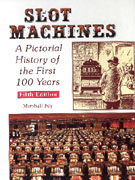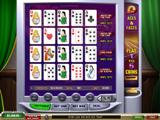
Slot Machines: America's Favorite Gaming Device
by Marshall Fey
The complete and colorful story of coin-operated chance machines from the time they first became prevalent in the early 1890's up to the slot machines operated in today's casinos. Included in the exciting drama of this major industry are the pioneer, inventors, manufacturers, operators and the numerous raids that plagued the industry. This book has been used as a source book worldwide, including television documentaries.
Online Multi-Hand Video Poker!
Casino Tropez has multi-hand video poker and it comes in a number of flavors. You can play 4 or 25 hands Aces & Faces, 4 hand Jacks or Better and Deuces Wild or the 10 hand Jacks or Better progressive. The best deal for multi-hand play is the 4 hand Aces & Faces which has a great 99.3% return. If multi-hand video poker is your thing, try you hand today!
Video Poker, The Origins of the Game
In 1891, Sittman and Pitt of Brooklyn began to manufacture the first nationally known poker card machines. Most of the early models, called drop card machines, employed 50 cards on 5 drums, two cards short of a complete deck. Usually the cards missing were the Jack of Hearts and the Ten of Spades, cutting the possibility of a Royal Flush in half. Cards could also be rearranged on the reels to further reduce wins. Award cards were often printed on both sides with separate pay schedules for free drinks and cigars. Upon inserting a nickel and pushing the handle lever, the drums would spin and rotate the cards. A winning hand could pay up to 100 cigars or drinks for a Royal Flush, 40 for a Straight Flush, and lesser awards for a pair of Kings or better.
Pioneer slot manufacturer, inventor and operator, Charles August Fey, was an intimate participant in the first half-century of the industry. His three-reel Liberty Bell, built in 1899, would be the forerunner of more than a million bell slot machines manufactured over the next half century. However, his first forays into mechanical slots focused on poker games.
In 1896 Fey opened a factory at 406 Market Street, a location he proudly referred to as "the best-equipped shop west of the Mississippi." Included in the lines he created here were the wheel machines, capable of a cash payout, and the prevalent card machines. Two of these 50-card poker machines were the 6 Way Paying Teller, using 5 rows of drop cards, and a companion model called The Duke, which had cards mounted on 5 reels. While the ultimate poker machine would be one capable of paying awards automatically, this was not mechanically feasible with the five-reel machines.
In December 1897, the Superior Court decreed slot machines to be legal devices. This opened the door for a cash-paying poker machine. The following year Fey introduced the three-reel Card Bell. This was the first "bell" machine, a term which for many years was the common trade parlance for the three-reel slot machines used in casinos today.
The most difficult challenge for Fey was to create a machine with automatic payouts. He had to find a way to read the reel symbols and to accept both nickels and tokens, separating them so that the former were diverted to the cash can and the tokens to the payout slide assembly. The automatic payouts on the Card Bell ranged from 2 to 20 coins, the highest being paid when the player was able to line up a simulated Royal Flush, Ace, King, and Queen in one suit. It is not known how many of these Card Bell's were manufactured, but the only surviving machine (bearing serial number 5), which Charlie Fey rescued from the 1906 earthquake and fire, is today enshrined in his grandsons' Liberty Belle Saloon and Restaurant in Reno, Nevada.
The most important innovation in poker machines came in 1901 when Charles Fey added the "draw" feature. On the first pull, all five drums of cards began to spin. When they stopped, the player had the option of improving his hand by pushing corresponding buttons to hold selected cards. A second handle pull would spin the remaining cards and the final hand would appear. According to Fey, "When I built the original draw poker machine, I found it to be the most consistent money maker in counter games that I have known." A later adaptation, Skill-Draw, "is the same game with all the old fascination, modernized to meet present day operating conditions." The game became so successful between 1935 and 1941 that Fey gave his top Skill-Draw salesman a new LaSalle automobile.
[ learn video poker! ]

